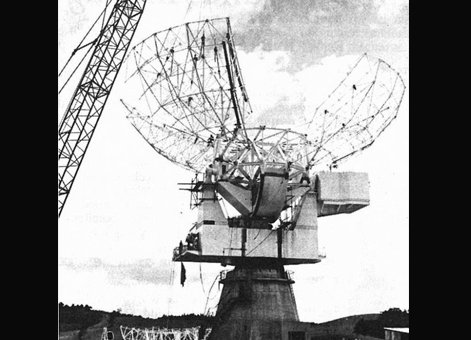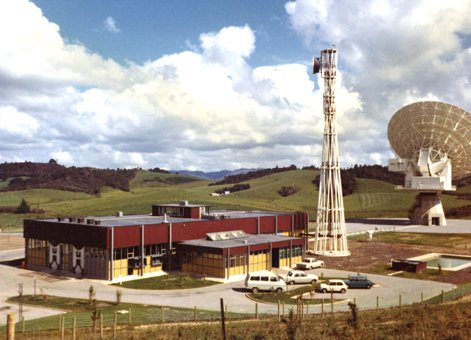The 1960s saw New Zealand becoming increasingly linked to the rest of the world through extended existing and new communications technologies.

Antenna reflector under construction, 1971, Engineering New Zealand, Vol, 26 1971, p.127.
These included the completion of the Commonwealth Pacific (COMPAC) submarine telephone cable system in 1963 and an extension by way of the South East Asia Commonwealth (SEACOM) system to south-east Asia in 1967.
In October 1965 New Zealand also began using the geostationary satellite INTELSAT-1, nicknamed the “Early Bird” satellite, to obtain additional telephone circuits across the Atlantic Ocean to the United Kingdom. Initially these were time-switched each day to fit with traffic peak flows across the Atlantic. Early concerns that the extra signal transit time via the satellite hop might cause difficulties in holding satisfactory conversations were quickly dispelled.
However, with an ever-increasing demand for high quality telephone, data, telex, telegraph and television circuits, especially as colour television broadcasts were about to start up in New Zealand, a communications satellite system was seen as the next step.
Because satellite technology was still developing, there was uncertainty about which system would be implemented.
One possibility was a low orbit, multi-satellite system which would require very directional, steerable antennas to track satellites as they moved across the sky in low-earth orbit. If this system was chosen, at least two antennas would be needed, so while one was tracking a satellite across the sky, the second would be aimed ready to pick up the signal from the next one as it came into view.
The other option was a geostationary satellite system which would require a somewhat larger antenna pointing at a relatively fixed position in the sky. Geostationary satellites at a height of nearly 36,000 kilometres above sea level at the equator have a single hop (that is, sender-satellite-receiver) signal propagation time of about one quarter of a second. Because of the much longer signal path and hence signal strength loss, a larger antenna would be required with a higher power transmitter, and a more sensitive receiver.
This latter arrangement was eventually chosen, and remains in use internationally today, not only for international communications (telephone, facsimile, data and studio-to-studio television links), but also for television broadcasting.
Warkworth Satellite Earth Station development
The first step in the project was to select a site for the satellite earth station. This was not an easy task because of various considerations. The criteria included screening from other radio transmissions, such as radar, a good horizon to enable a clear view of the sky, easy access for power, a communications link back to the international telephone exchange at Auckland, access to mains power supply, and good weather without excessive wind speeds. A site north of Auckland was also preferred to avoid the antenna having to “look” through the aircraft flight paths and holding patterns associated with Auckland International Airport. Good rock foundation conditions were vital as well, in order to support the 2,300-ton weight of the 30-metre diameter antenna with its massive reinforced concrete pedestal.
The antenna reflector, or “dish”, consists of a large number of separate panels, each of which had to be perfectly positioned using precise surveying means. Fortunately the Government had previously asked the Department of Scientific and Industrial Research (DSIR) to set up a section that could carry out survey work to aid in the creation of industries. Consequently the DSIR agreed to carry out the survey and adjustment of all the plates at no cost. Site development to begin in 1969.

Warkworth Satellite Earth Station, 1971, Photograph courtesy of the J. R. Diamond Collection.
Multiplex Equipment
Standard multiplex carrier telephony equipment was used, whereby single-sideband modulation technology is used to combine 12 voice-grade circuits into a Group. Five Groups were combined into a Supergroup. Combinations of these formed the standard 24, 60 and 132 channel basebands used on the satellites. These were then frequency-modulated onto the microwave carrier in the 6 gigahertz (GHz) band for transmission to the satellite through a 3 kilowatt klystron. The received signal in the 4GHz band was amplified in a low-noise receiver before passing to the multiplex equipment.
A standard 16 Supergroup baseband was available on the microwave system connecting back to the international telephone exchange in the Airedale Street building in Auckland.
Television Broadcasts
Colour television broadcasts were beginning in New Zealand at the time, and it was recognised that the broadcaster would require high-quality video links to and from other countries for news reports and coverage of important events.
One major problem was New Zealand had adopted the 625-line Phase Alternate Line (PAL) standard while a few other countries, notably the United States of America and Canada, were continuing with the older 525-line National Television System Committee (NTSC) standard. These standards were incompatible, so it was necessary to convert from one standard to the other, using a newly developed Field Store Standards Converter which occupied an entire row of equipment. In fact, the design was so new, with much novel use of technology, some appreciable local input and innovation was required to achieve and maintain satisfactory operation.
Power supplies
Continuity of service was ensured by a purpose-designed no-break power system feeding all vital equipment. The incoming mains was rectified to float a 300 volt lead-acid battery which in turn fed static inverters feeding the essential load busbars. The battery was backed up by auto-start diesel engine-alternator sets.
Construction professionals
Principal contractor: Nippon Electric Company with local agent William Scollay and Company Limited Architect for site and buildings: New Zealand Ministry of Works Main Building Contractor: Wiles and Jones
Antenna Structure Contractor: McConnell Dowell Limited
Completion Date: 17 July 1971.
Find out more
Access
There is no public access to the station and its surrounding land, but a general view is possible from Satellite Station Road. A plaque and tree planted in honour of the visit of Dr Kobayashi of NEC (Nippon Electric Company) in 1983 are to the right of the roadway, close to the perimeter fence.
Further reading
'New Zealand satellite earth station’, New Zealand Engineering, Vol.26:5 (15 May 1971), pp.122-27.
Location
The Warkworth Satellite Earth Station is located 5km south of Warkworth, on Satellite Station Road.
